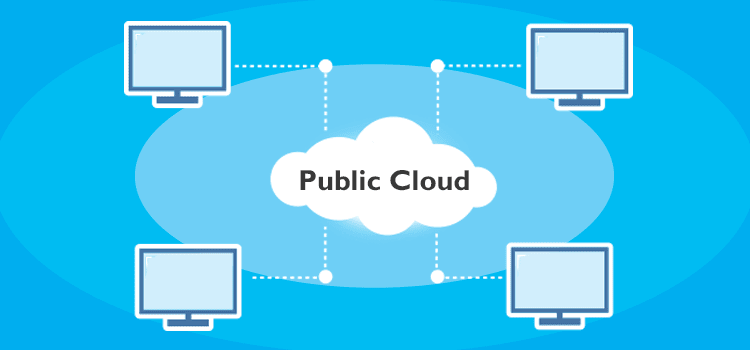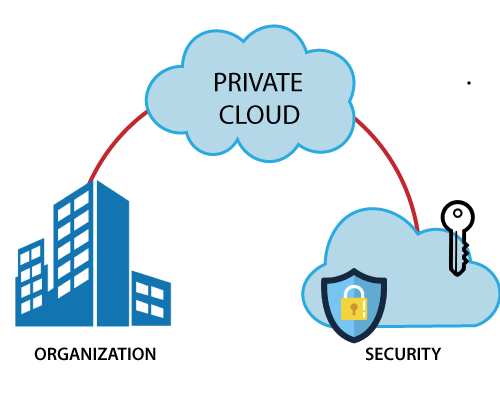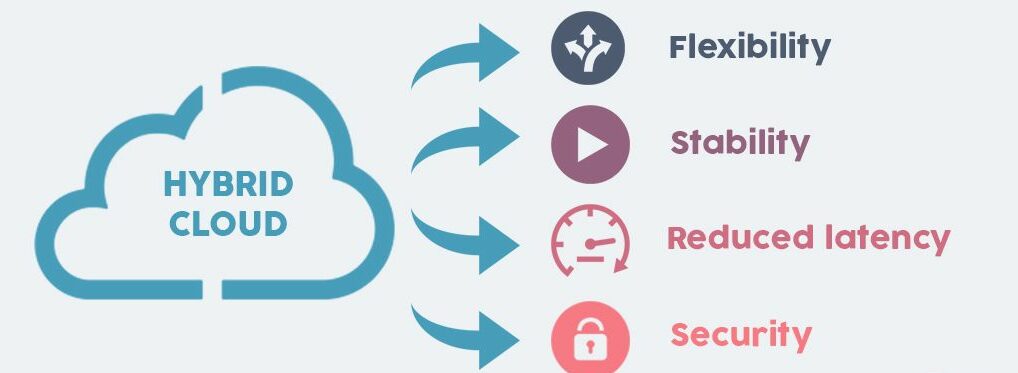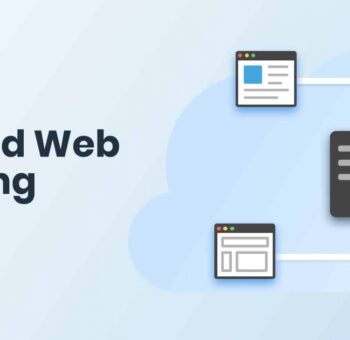Hybrid cloud strategies are becoming more popular. According to research, businesses using a hybrid strategy increased to 60% in 2019 from 50% in 2018. But what exactly is a hybrid cloud infrastructure, and is it appropriate for your business? We’ll go through the fundamentals of hybrid cloud and the primary benefits of switching to a hybrid approach in the sections below.
Different Deployments: Public, Private & Hybrid Cloud
Cloud computing can be deployed in various ways that provide its benefits. You can choose from public, private, or hybrid clouds. In order to better understand hybrid clouds, we need to look at both public and private clouds.
Public Cloud

The public cloud is a large, shared cloud area offering a lot of space and scalability. This type of space is typically less expensive because it is shared, and it provides enterprises with access to the data centre where their server resides, which provides security and backup services. Several firms usually share the cost of such infrastructure and services.
Private Cloud

Unlike public clouds, private clouds are secure and only store data of one company. In general, this space does not share resources with other enterprises, and is primarily used by enterprises that need to comply with regulatory requirements with regard to their data, or have extremely sensitive data that must be kept separated from other users physically and conceptually.
What is Hybrid Cloud ?

A private cloud is protected by firewalls and stores the data of a single company on a single server. Usually, this space is used by enterprises that need to comply with regulatory requirements for their data or have extremely sensitive or proprietary information that needs to be kept physically and conceptually separate from other users.
Public cloud services are hosted in clients’ on-premise data center location, and private clouds are constructed in vendor-owned data centers. Workloads can be migrated between private and public clouds using hybrid cloud models.
When it comes to data deployment, businesses have more flexibility and agility when moving data between cloud environments. Each hybrid cloud system is unique since it depends on the objectives and goals of the organization.
Hybrid Cloud: Right or Not!!

Many forward-thinking businesses are opting for hybrid cloud solutions because not everything belongs in the public cloud. Combining the benefits of both public and private clouds, hybrid clouds utilize existing data center infrastructure.
Apps and components can integrate across instances of the cloud and even across architectures via the hybrid approach. Dissemination and access flexibility apply to data as well. When working in the dynamic digital world, you should plan for workloads and datasets to shift around as needs change. It is possible that apps or data stored today will no longer be the ideal place to be stored in the future.
A hybrid cloud architecture has these characteristics mentioned below:
- With a single data management system, resources in your on-premises data center, private cloud, and public cloud can all be managed.
- Those systems which run mission-critical apps or store sensitive data cannot be connected to the public cloud.
Data Fabrics enable hybrid cloud architectures with a software-defined approach for delivering a set of data services across any mix of IT resources.
Hybrid Cloud: Scenarios
- Dynamic Changing Workloads: Using an easily scalable public cloud for your dynamic workloads, and storing less volatile or sensitive workloads on-premises or in your private cloud.
- Segregating Critical Workloads From Less-Sensitive Workloads: In order to store sensitive financial and customer information, you might use a private cloud, while the rest of your business applications may be run from the public cloud.
- Large Data Processing: There is no guarantee that you can keep up with the rate at which you analyze data in large quantities. To maintain data security and keep critical big data behind your firewall, you may also use public cloud resources for some of your large data analytics.
- Moving As per the Needs: Consider using a public cloud or a small-scale private cloud for certain workloads. Make sure your company’s cloud presence is tailored to your specific needs and extend it as needed-whether a hybrid cloud, a public cloud, or a private cloud.
- Temporary Processing & Capacity Needs: For short-term projects, using a hybrid cloud can reduce cost compared to using your own data center infrastructure. By doing so, you won’t waste money on equipment you’ll only use for a short time.
- Best of Both Deployments: Do you really need a public cloud or a private cloud solution unless you have specific needs that can only be met by these solutions? You can take advantage of the best of both worlds with a hybrid cloud strategy.
Hybrid Cloud Benefits
There are wide-ranging benefits of Hybrid Cloud and we are here with a detailed list of benefits for you. Read below.

Control
Hybrid cloud solutions give you a great deal of control. A hybrid cloud model enables businesses to customize the private end of the cloud to meet the needs of their own company and make changes as they see fit instead of outsourcing their entire IT infrastructure to a third party cloud provider. As a networked enabled application keeps its underlying component private, internal IT staff members can handle day-to-day management of servers and other infrastructure.
The fact that public cloud providers are responsive to some extent is a plus to some firms, but they stand to gain much more from having direct control over their assets in a hybrid cloud architecture. In today’s fast-paced economy, circumstances and needs can change frequently. Cloud computing platforms, which mostly house critical data assets for a business, can be reconfigured and changed to respond to those changes quickly and with little downtime. You are also less likely to be caught by abrupt changes to the terms and conditions of a cloud provider.
-
Business Flexibility and Agility
Many companies are always on the hunt for solutions that provide them with the most cutting-edge resource utilization and infrastructure utilization. Although moving the entire organization to the cloud is challenging, on-premise infrastructure can still be maintained.
Companies that offer hybrid cloud solutions combine on-premise infrastructure with public and private clouds to increase business agility. Consequently, you will not have to worry about IT issues when making changes to your company.
-
Risk Management & Improved Security
By minimizing data exposure, hybrid cloud computing offers businesses greater control over their data and greater security.
The location of data and workloads can be affected by compliance, regulatory, and security concerns. In the hybrid environment, security teams can take advantage of backup and insurance services relying on redundant cloud storage.
It is also easier to manage risk using a hybrid cloud’s centralised management, which allows you to easily integrate technological security functions like encryption, access control, automation, orchestration, end-point security, etc.
-
Speed

One advantage of maintaining control over network-enabled programs is their speed. Although hybrid cloud architecture is often faster than multi-cloud or a fully public cloud environment, this is not always the case. IT professionals may, however, optimize the network to reduce latency and make data transmission faster. A hybrid environment can boost speed and bring critical services close to end users by leveraging edge computing architectures.
Public clouds, however, must spread their resources and provide many things for many users, as opposed to private clouds, which can be specifically designed and have fewer resource requirements. In the private section of a hybrid cloud, users can tailor the network so that only vital traffic passes through in addition to non-essential operations being moved to the public cloud.
-
Virtual Desktops Simplified Management
On-premise virtual desktop deployments are expensive and time-consuming. The IT department and you are responsible for all IT issues. As a business owner, you cannot afford to waste time on IT troubles when you have more pressing matters to attend to.
Desktop As a Service (DaaS) is a managed cloud solution offered by HCI providers that allows users to use their hybrid cloud servers to create virtual desktops. These PCs are installed and maintained by the supplier, so you can access them directly from your personal devices. Additionally, providers offer customized solutions for migrating your on-premises infrastructure to the cloud.
-
Cost Control
In a private cloud, companies need to carefully select the types of workloads and services they wish to run. To set up and maintain a private cloud, a company must dedicate a large amount of cash, equipment, and talent. Despite the fact that private clouds are able to manage local resources in a cloud-like manner, they are limited in terms of infrastructure.
A public-private cloud connection can save a business money. By drawing on public cloud resources when local demand exceeds capacity, the link helps to smooth spikes in activity. A public cloud can be used to save time and money for a company’s temporary, experimental, or general-purpose workloads that they don’t want to source, set up, or manage internally. Consider executing data and workloads where the costs are the lowest – or use finite resources in the private cloud.
In addition, hybrid cloud’s cost advantages make it clear where the money goes. Using a hybrid cloud, you can easily distinguish capital from operational expenditures. Cloud technologies can enable companies to measure and track their cloud usage, as well as the costs of the services according to departments and workloads.
-
Dynamic Workload

If you have multiple needs, a public or private cloud may not be sufficient to meet them all. Using the public cloud will not provide the same level of security or isolation as a private cloud. This increases the risk of storing critical data in a public cloud.
With the hybrid method, you can move workloads dynamically. Using public cloud technology for business-related functions means storing sensitive information on private cloud servers or on-premise data centres.
Read More: Benefits of Cloud Computing
Last Say!!
With the ongoing pandemic, businesses are experiencing certain difficulties as a result of insufficient IT capabilities. Solution such as DaaS helped businesses remain viable in the long term. DaaS with hybrid cloud infrastructure allows companies to scale and migrate their on-premises Virtual Desktop Infrastructure (VDI) to the cloud. A hybrid DaaS provider can create virtual desktops faster and more efficiently, without geographic restrictions.
We hope you got every information related to Hybrid Cloud Infrastructure. For any further issues, you can reach out to us anytime via mail, call or chat support services.


